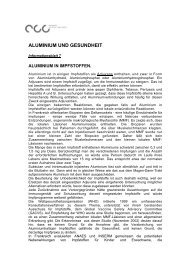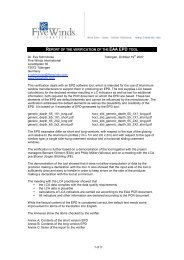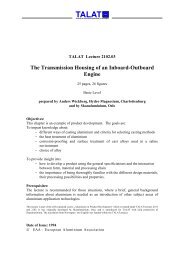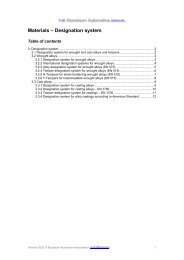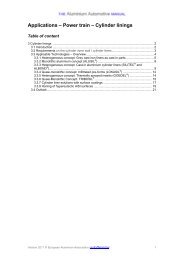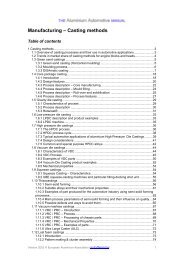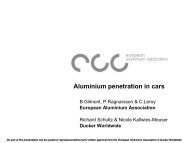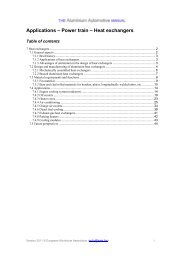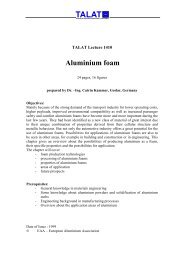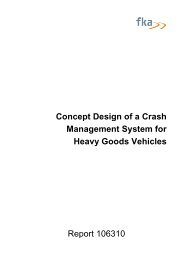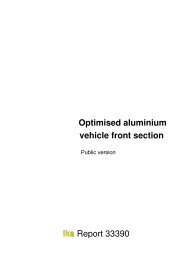aluminium in commercial vehicles - European Aluminium Association
aluminium in commercial vehicles - European Aluminium Association
aluminium in commercial vehicles - European Aluminium Association
You also want an ePaper? Increase the reach of your titles
YUMPU automatically turns print PDFs into web optimized ePapers that Google loves.
114 EUROPEAN ALUMINIUM ASSOCIATION ALUMINIUM IN COMMERCIAL VEHICLES CHAPTER VIII<br />
3.4. Pulsed current MIG<br />
weld<strong>in</strong>g<br />
An improvement of the MIG<br />
process has been achieved by<br />
superimpos<strong>in</strong>g a pulsed current<br />
over the ma<strong>in</strong> current, the object<br />
be<strong>in</strong>g to ma<strong>in</strong>ta<strong>in</strong> a low average<br />
current level without sacrific<strong>in</strong>g<br />
arc stability.<br />
The filler metal is transferred to<br />
the weld pool every time the current<br />
is high (i.e. one drop of metal<br />
per pulse). The "cold times"<br />
when the current is low ensure<br />
that arc stability is ma<strong>in</strong>ta<strong>in</strong>ed.<br />
There are three operat<strong>in</strong>g modes:<br />
• synergetic mode: only the<br />
rate of uncoil<strong>in</strong>g has to be regulated.<br />
The voltage and frequency<br />
are regulated by electronic logic<br />
circuits;<br />
• manual mode: all the weld<strong>in</strong>g<br />
parameters are adjustable;<br />
• programme mode: each<br />
parameter can be stored for<br />
use accord<strong>in</strong>g to production<br />
requirements.<br />
The pulsed MIG process is limited<br />
to th<strong>in</strong> products of 2 < t ≤ 5 mm<br />
and to vertical fillet welds.<br />
This process makes it possible to<br />
weld th<strong>in</strong> gauge material with<br />
standard filler wire. As the weld<br />
pool can be better controlled,<br />
butt welds up to 5 mm thickness<br />
can be executed without back<strong>in</strong>g<br />
bar. Furthermore it is very helpful<br />
for weld<strong>in</strong>g <strong>in</strong> the vertical and<br />
the over head position. The optimal<br />
mach<strong>in</strong>e sett<strong>in</strong>g is more<br />
demand<strong>in</strong>g than for standard<br />
MIG because there are much<br />
more parameters to be def<strong>in</strong>ed.<br />
The width of the heat affected<br />
zone is analogue to the one for<br />
standard MIG as is also the<br />
amount of distortion of the work<br />
pieces.<br />
For weld<strong>in</strong>g over stitches see<br />
remark under 3.3 above.<br />
3.5. Wire pulsation<br />
For gauges between 1 and 3 mm,<br />
a complementary option “the<br />
wire pulsation” could be added to<br />
Weld<strong>in</strong>g<br />
of a truck door<br />
the previously described “current<br />
pulsation” <strong>in</strong> order to improve the<br />
arc stability. This “wire pulsation”<br />
<strong>in</strong>duces a double pulsation to current<br />
signal and consequently to<br />
the heat <strong>in</strong>put. For T-jo<strong>in</strong>t of dissimilar<br />
gauges, the heat <strong>in</strong>put distribution<br />
is difficult to ma<strong>in</strong>ta<strong>in</strong><br />
constant with classical pulsed current.<br />
This double pulsation of current<br />
<strong>in</strong>sures the concentration of<br />
heat <strong>in</strong>put at the exact location of<br />
the jo<strong>in</strong>t.<br />
3.6. CMT – Cold Metal<br />
Transfer<br />
For MIG weld<strong>in</strong>g gauges lower<br />
than 1 mm, the CMT process<br />
(Cold Metal Transfer) could be<br />
used. When detect<strong>in</strong>g a shortcircuit,<br />
this process retracts the<br />
wire so as to help detach the<br />
droplet. The thermal <strong>in</strong>put is<br />
immediatly reduced and the<br />
short-circuit current is kept small.



